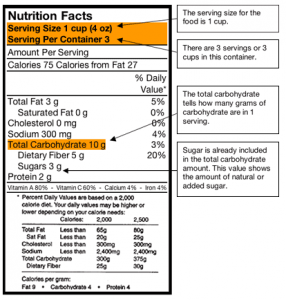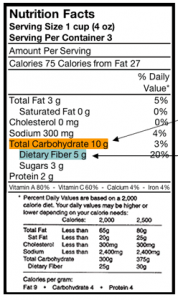Nutritional Value of Carbohydrates
Good vs Bad Carbs
Adapted from www.everydayhealth.com (http://www.everydayhealth.com/diet-nutrition/101/nutrition-basics/good-carbs-bad-carbs.aspx)
Carbohydrates, often referred to as “carbs,” are your body’s primary energy source, and they’re a crucial part of any healthy diet. Carbs should never be avoided, but it is important to understand that not all carbs are alike.
Carbohydrates can be either simple (nicknamed “bad”) or complex (nicknamed “good”) based on their overall chemical structure.
Simple carbohydrates are composed of simple-to-digest, basic sugars (such as mono– or di-saccharides). As a general rule of thumb, the higher in sugar and lower in fiber a food is, the worse that food is for you.
The most important simple carbohydrates to limit in your diet include:
While simple carbohydrates are safe to enjoy on occasion, you want to avoid having them as a primary sources of carbs. Also, within the simple carb category, there are “smarter” choices, such as a baked potato, white rice, and regular pasta, than others (e.g. chips, cakes, pies, and cookies).
Complex carbohydrates consist of longer-chains of polysaccharides, such as fiber, and are found in foods such as whole grains and legumes. From a metabolism perspective, complex carbohydrates usually take more time for the body to break down and use. As a result, they generally have a lower glycemic load, which means that during digestion, lower amounts of sugars are released at a more consistent rate (instead of in rapid spikes as in the case of simple sugars) to keep you going throughout the day.
Selecting complex carbohydrates over simple carbohydrates is a simple matter of making dietary substitutions. For example, have brown instead of white rice or whole-wheat instead of plain white pasta. To help determine which foods are rich in ‘good’ or ‘bad’ carbs, you can refer to the nutritional label of packaged food.
Counting Carbs
To monitor intake of carbohydrates, particularly when eating pre-packaged foods, you can always review the FDA-mandated nutritional label that should appear on all packaged food sources. When couting carbohydrates, there are three things to consider when reviewing a nutritional label:
- Number of servings
- Serving size
- Total grams of carbohydrates per serving

In the example, the total carbohydrate value indicates how many grams of carbohydrate are in one serving, in this case 10 grams. Since there can be more than one serving in a package, to calculate the total number of carbohydrates in a package, you would need to multiply the grams of carbohydrate by the number of servings in the package – 30 grams in this case.

For diabetics or anyone closely monitoring their carbohydrate intake, it is important to note that the grams of dietary fiber are already included within the total carbohydrate count (see right). However, because fiber is a complex form of carbohydrate that your body digests and absorbs slower than simple sugars, it has a lower glycemic index.
Good Carbs vs Bad Carbs (from HealthiNation)
Carbohydrates, often referred to as “carbs,” are your body’s primary energy source, and they’re a crucial part of any healthy diet. Carbs should never be avoided, but it is important to understand that not all carbs are alike.
Carbohydrates can be either simple (nicknamed “bad”) or complex (nicknamed “good”) based on their overall chemical structure. The video below describes the differences between these two types of carbohydrates.
Original Source: https://www.youtube.com/watch?v=6esFOqj_IaY

In the sample Nutritional Label, 1 serving(s) of Macaroni and Cheese would contain:
- 250 Calories
- 31 grams Total Carbohydrates
- 5 grams of Simple Sugars
- 0 grams of Dietary Fiber
Summary
Carbohydrates are one of the three macronutrients that provide energy to our bodies. Carbohydrates are an excellent energy source during exercise, help spare body protein from catabolism, prevent ketosis, and provide 4 kcal of energy per gram. Once broken down into simple sugars by our digestive system, they are absorbed into the bloodstream and travel to the liver where, if necessary, they are converted to glucose. Glucose is either used by the cells for energy or is converted to glycogen and stored in the liver and muscle for later use, or stored as fat if there is an excess.
Insulin assists with the transport of glucose into the cells. The glycemic index and glycemic load are values that indicate the potential of foods to raise blood glucose and insulin levels. The higher the glycemic index/load, the larger the increase in blood glucose and insulin levels. Diabetes is a chronic disease caused by insufficient insulin (Type I) or by the cells becoming resistant or insensitive to insulin (Type II- more common and usually diet related). Diabetes causes dangerously high blood glucose levels which can cause multiple health issues.
Complex carbohydrates are healthier to consume because they contain fiber and other nutrients that can reduce the risk for obesity, colon cancer, heart disease, and diabetes. Fiber also helps to prevent hemorrhoids, constipation, and diverticulosis and may assist with weight loss. The RDA for carbohydrate is 130 grams per day, and the AMDR is 45–65% of total energy intake. The Adequate Intake for fiber is 25 grams per day for women and 38 grams for men. Added sugars—sugars and syrups added to foods during processing—can cause tooth decay, elevate triglycerides and LDLs, and contribute to obesity and diabetes. A great rule of thumb to determine a healthy mix of carbohydrates when reading food labels is looking for a minimum of 2 grams of fiber per 100 Calories of carbohydrates.